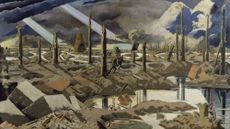A Neolithic marvel in southeast Turkey
A trip to Göbekli Tepe offers visitors the chance to explore nearby Sanlıurfa

Since their discovery in 1995, the Neolithic remains at Göbekli Tepe in southeast Turkey have prompted "a reconsideration of the standard timeline of human civilisation", and spawned "sensational Netflix shows and the woolliest of speculative theories".
Recent discoveries have put paid to some of those, said Barry Yourgrau in The New York Times, but Göbekli Tepe – one of the first known examples of human-made monumental architecture – remains among the world's most important archaeological sites. Dating from about 9400 BC, its round-oval structures are also remarkably beautiful, with their anthropomorphic megaliths and delicate carvings of insects, donkeys and lions. And the trip to see them offers another pleasure, too – the chance to explore the nearby city of Urfa, or Sanlıurfa, which has its own architectural heritage and "vivid food culture".
An important commercial centre since the third century BC, Urfa is a "palimpsest of civilisations", from the Aramaic and Hellenic to the Arab and Ottoman. Today, it is a "conservative Islamic city", where the labyrinthine bazaar resounds with the sound of the Arabic, Kurdish and Turkish languages. Its most famous sight is the "handsome" religious complex of the Pool of Abraham, created – legend has it – when the Assyrian king Nimrod flung the prophet Abraham onto a blazing pyre, only to have God turn the flames into water and the fiery logs into carp. There is also a museum housing the world's oldest-known life-size human statue, the 11,000-year-old "Urfa man".
Subscribe to The Week
Escape your echo chamber. Get the facts behind the news, plus analysis from multiple perspectives.

Sign up for The Week's Free Newsletters
From our morning news briefing to a weekly Good News Newsletter, get the best of The Week delivered directly to your inbox.
From our morning news briefing to a weekly Good News Newsletter, get the best of The Week delivered directly to your inbox.
Göbekli Tepe sits high up in the stony hills nearby. When discovered, it appeared to be an isolated ritual site, upsetting the consensus that humans began constructing such buildings only after they'd settled in villages. But domestic structures have since been found nearby, suggesting that the "temple" might have developed alongside the "city". And the surrounding hills seem to be full of discoveries yet to be made.
Sign up to The Week's Travel newsletter for destination guides and the latest trends

Continue reading for free
We hope you're enjoying The Week's refreshingly open-minded journalism.
Subscribed to The Week? Register your account with the same email as your subscription.
Sign up to our 10 Things You Need to Know Today newsletter
A free daily digest of the biggest news stories of the day - and the best features from our website
-
 Terry Venables: the irrepressible manager with a remarkable footballing brain
Terry Venables: the irrepressible manager with a remarkable footballing brainObituaries 'Brilliant man-manager' who gave England fans some of their best moments of recent times
By The Week UK Published
-
 The Week Unwrapped: Nikki Haley, leaseholds and the death of funerals
The Week Unwrapped: Nikki Haley, leaseholds and the death of funeralsPodcast Has Donald Trump met his match? Will a new law help homebuyers? And why are funerals falling out of favour?
By The Week Staff Published
-
 Shein: the biggest Wall Street float of 2024?
Shein: the biggest Wall Street float of 2024?Speed Read Clothing industry disruptor is about to test its acceptability on the US stock market
By The Week UK Published
-
 Shein: the biggest Wall Street float of 2024?
Shein: the biggest Wall Street float of 2024?Speed Read Clothing industry disruptor is about to test its acceptability on the US stock market
By The Week UK Published
-
 Shakespeare's First Folio: 400 years in print
Shakespeare's First Folio: 400 years in printThe Explainer First published in 1623, seven years after his death, the weighty tome includes Macbeth, Antony and Cleopatra, Julius Caesar
By The Week UK Published
-
 Properties of the week: stunning houses for winter sun
Properties of the week: stunning houses for winter sunThe Week Recommends Featuring a beachfront cottage in Grand Cayman and a villa in Costa Rica with sea and jungle views
By The Week UK Last updated
-
 Blavatnik Galleries review: how art is war's 'most truthful witness'
Blavatnik Galleries review: how art is war's 'most truthful witness'The Week Recommends New space displays some of the Imperial War Museum's finest art, film and photography
By The Week UK Last updated
-
 Christmas 2023: best stocking fillers and Secret Santa gifts
Christmas 2023: best stocking fillers and Secret Santa giftsThe Week Recommends The wish list includes boozy crackers, slippers, bath treats, socks and chocs
By The Week UK Published
-
 6 welcoming homes great for family gatherings
6 welcoming homes great for family gatheringsFeature Featuring a home with 13 fireplaces in Maine and a home with heated brick floors in New Mexico
By The Week US Published
-
 Christmas 2023: best food and drink hampers
Christmas 2023: best food and drink hampersThe Week Recommends Everything you need for a festive feast – from the turkey and trimmings to the dessert, cheese and wine
By The Week UK Published
-
 Christmas 2023: best alcohol gift sets and festive drinks
Christmas 2023: best alcohol gift sets and festive drinksThe Week Recommends Boozy presents, seasonal bottles and unique items for your home bar
By The Week UK Published









